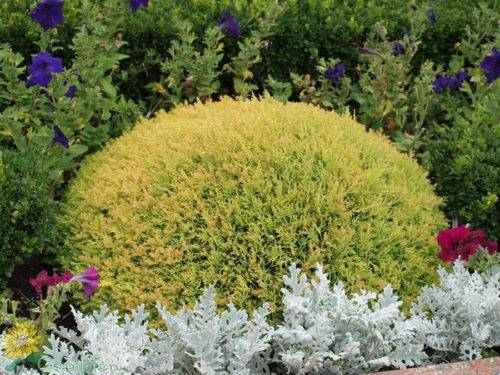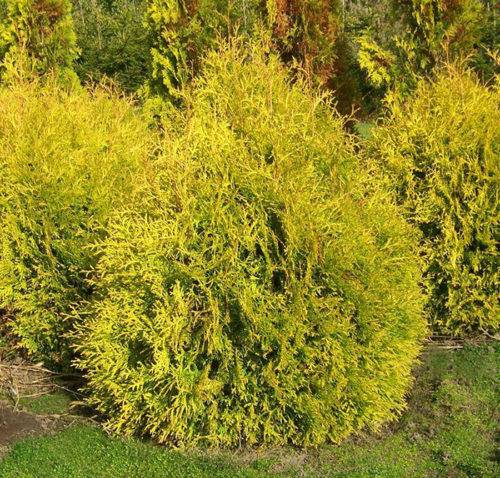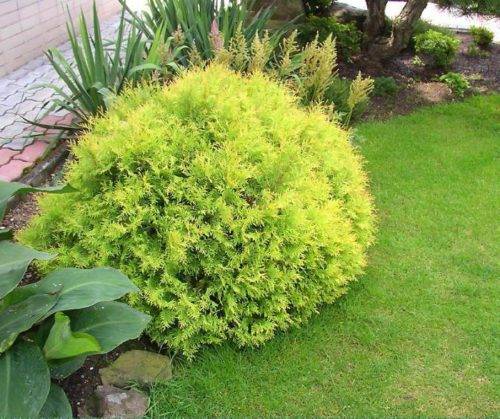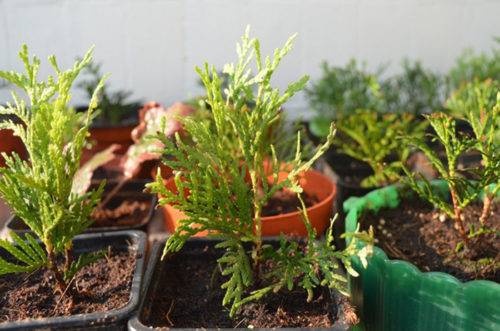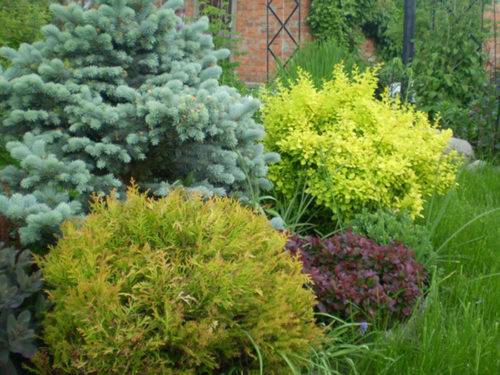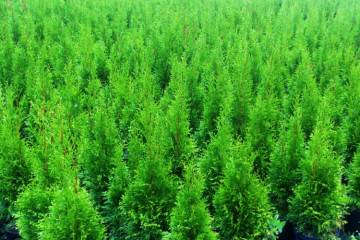Thuja Reingold (Rheingold) western - description
Content:
Thuja has long and firmly become one of the leaders among plants, often used in various types of landscape design. This evergreen plant is so attractive that it organically fits into almost any garden composition. Thuja western Reingold stands out among other plant species for its brightness and color.
Thuja Reingold (Rheingold) western: description and dimensions
Thuja Reingold is an evergreen perennial. This shrub is naturally widespread in North America, where it lives en masse on the banks of rivers, in marshy areas, lowlands.
Thuja Rheingold, whose name means "golden rain", differs among other plants of the genus by a specific crown, which can change with age. Also, this species is characterized by a change in the shades of the needles during the season: from pink to rich yellow and orange.
Thuja western Reiggold belongs to dwarf plants, since in cultural conditions its height does not exceed 2-2.5 m.
The shrub consists of soft and short branches, first with needle-like and later with scaly foliage. But not only the color of the needles attracts the attention of the plant, it is able to change the shape of the crown over time. So, at a young age, thuja has a hemispherical shape, and by the age of 15-20 it becomes spherical. Subsequently, thuja Reingold becomes conical, while it is distinguished by its high density.
The roots of the evergreen beauty are neat, but at the same time quite powerful. The bark on young shoots is reddish and smooth, and eventually becomes grayish and divides into strips. A specific feature of the plant is that every few years the needles completely die off and fall off.
In addition, thuja is a well-known long-liver that can grow in one place for almost two centuries in a row. And Tui is also characterized by increased frost resistance, it calmly tolerates a drop in temperature to -35-40 ° C.
Planting and caring for thuja Reingold
For planting thuja, you need to select sunny areas, since with a lack of lighting, the golden needles of the plant will not be very bright. But at the same time, the planting site should be well protected from drafts, and the soil should be light and nutritious with a low occurrence of groundwater, which can be detrimental to the plant.
Caring for the plant is not particularly difficult, you just need to follow some recommendations.
- Watering mode. Thuja loves moisture, so you should not skimp on watering. The procedure is carried out twice a week, watered abundantly. A good guideline for watering is the condition of the needles: if the plant does not have enough moisture, it will begin to dry. In addition, young plants love irrigation, which can be done every day during drought, but not in the middle of the day.
- Top dressing. During the first few years, the plant does not need fertilization, making do with the reserves that were introduced into the soil during planting. In the future, humus is used for feeding, which is introduced into the trunk circle, and complex mineral fertilizers, poured in spring and summer.
- Features of summer care.Summer care consists in timely (the next day after watering) loosening of the soil, avoiding the formation of a crust. Weeds also need to be removed. In both cases, mulching can come to the rescue. It is carried out using crushed bark or dry peat.
- Preparation of thuja Reingold for winter. In a fairly mild climate, the plant does not need additional cover. But since there is a danger of getting burns, it is better to mulch the trunk circle with fallen leaves, spruce branches. If the winter is supposed to be very harsh, then it is better to protect young plants by building a tripod and wrapping it with covering material.
Reproduction of thuja Reingold
Thuja is a rather unpretentious plant, so usually there are no problems with its reproduction. The shrub can be propagated using cuttings, seeds and twigs.
Seeds are usually propagated by species of thuja in order to obtain new plants that will lack the characteristics of the parent plants.
Propagation by cuttings
This method is used most often, since it is the simplest and is suitable for obtaining a large amount of seedlings at once. The main stages of this process are:
- Cuttings are harvested from strong healthy shoots (not too old and not quite young).
- The lower part of the cuttings is cleaned, removing needles and twigs from it.
- It is advisable to process the cuttings with a special root former.
- Prepared cuttings are planted (to a depth of no more than 1.5-2 cm) at an angle of 60 ° in massive tubs with a specially mixed substrate, which must include sand, turf and peat.
- Tubs with plants must be placed in a greenhouse, where the temperature should be around 22-23 ° C all the time.
- Irrigate the soil in the flowerpot regularly from a sprayer.
- As soon as shoots begin to appear on the cuttings, you can begin to air them, loosen the soil around them and fertilize.
- With the arrival of autumn, such young plants can already be planted in open soil. If the winter is expected to be harsh, then it is better to insulate the plantings with the help of dry leaves, sawdust, spruce branches.
Why does thuja Reingold turn yellow
The unusual appearance of Thuja Reingold is associated with the color of its scales, which changes depending on the season. But when growing this variety of thuja, you need to carefully inspect the plant for the appearance of insect pests (it can be aphids, false shield, moth) and carry out preventive treatments that will help protect the thuja.
The appearance of thuja Reingold and its description allow us to assert that it is a universal solution for any landscape design option. Its bright needles and original crown are able to decorate and revive any, even the most gloomy area. In addition, the original Reingold thuja does not require much experience and special skills when planting and caring for it, even a novice gardener can handle this.
